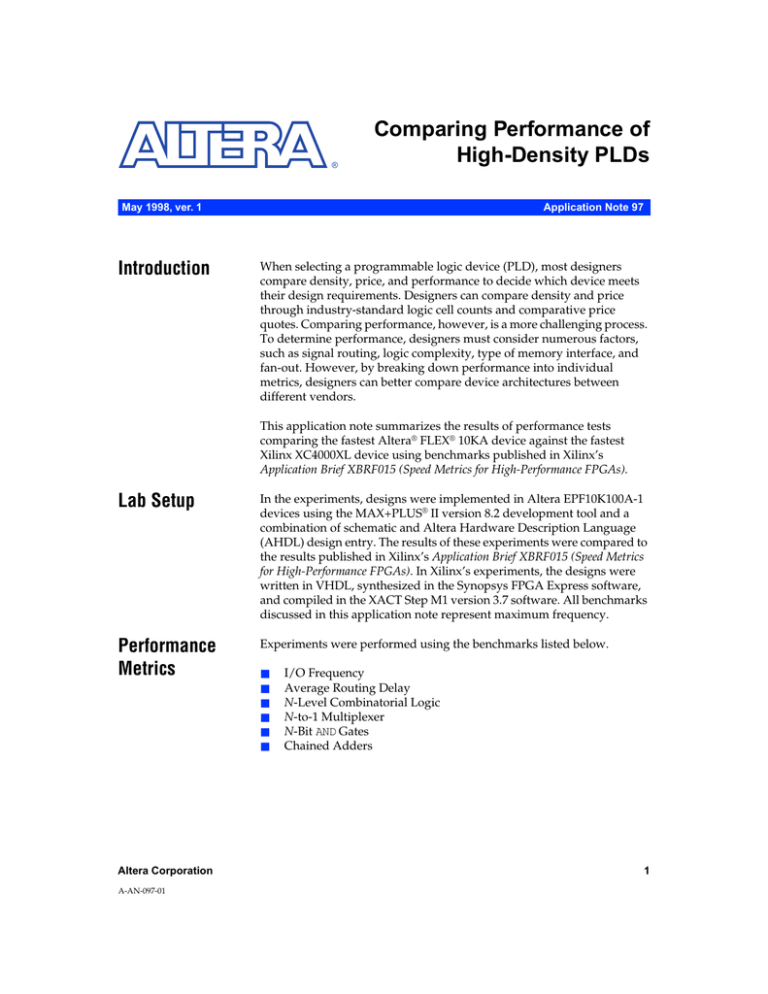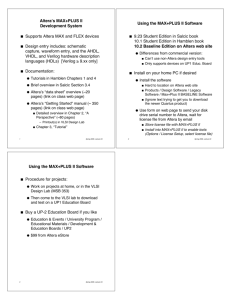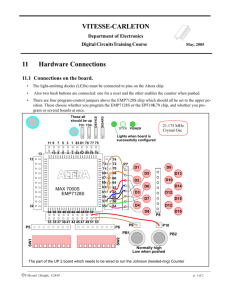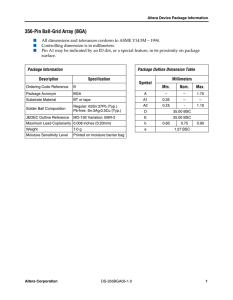
®
Comparing Performance of
High-Density PLDs
May 1998, ver. 1
Introduction
Application Note 97
When selecting a programmable logic device (PLD), most designers
compare density, price, and performance to decide which device meets
their design requirements. Designers can compare density and price
through industry-standard logic cell counts and comparative price
quotes. Comparing performance, however, is a more challenging process.
To determine performance, designers must consider numerous factors,
such as signal routing, logic complexity, type of memory interface, and
fan-out. However, by breaking down performance into individual
metrics, designers can better compare device architectures between
different vendors.
This application note summarizes the results of performance tests
comparing the fastest Altera® FLEX® 10KA device against the fastest
Xilinx XC4000XL device using benchmarks published in Xilinx’s
Application Brief XBRF015 (Speed Metrics for High-Performance FPGAs).
Lab Setup
In the experiments, designs were implemented in Altera EPF10K100A-1
devices using the MAX+PLUS® II version 8.2 development tool and a
combination of schematic and Altera Hardware Description Language
(AHDL) design entry. The results of these experiments were compared to
the results published in Xilinx’s Application Brief XBRF015 (Speed Metrics
for High-Performance FPGAs). In Xilinx’s experiments, the designs were
written in VHDL, synthesized in the Synopsys FPGA Express software,
and compiled in the XACT Step M1 version 3.7 software. All benchmarks
discussed in this application note represent maximum frequency.
Performance
Metrics
Experiments were performed using the benchmarks listed below.
Altera Corporation
A-AN-097-01
■
■
■
■
■
■
I/O Frequency
Average Routing Delay
N-Level Combinatorial Logic
N-to-1 Multiplexer
N-Bit AND Gates
Chained Adders
1
AN 97: Comparing Performance of High-Density PLDs
I/O Frequency
The I/O frequency (fIOEXT) benchmark measures the maximum
frequency that data can be transferred to and from a programmable logic
device (PLD) with its inputs and outputs registered. The equation for
calculating fIOEXT is shown below, assuming the hold time (tH) is zero:
1
fIOEXT = -----------------------t SU + t CO
Where:
tSU = Input setup delay
tCO = Clock-to-output delay
In this experiment, the tCO and tSU delays were measured on the rising
edge of a dedicated global clock signal feeding an I/O cell register, as
shown in Figure 1.
Figure 1. fIOEXT Circuit
The fIOEXT circuit used to measure the tCO and tSU delays of a device.
FLEX 10K Device
D
Q
Connection Made
on Circuit Board
Out
DFF
In
D
Q
Global Clock
DFF
To accurately determine the fIOEXT between two devices on a printed
circuit board (PCB), designers need the individual tSU and tCO values for
each device. Designers can then determine the system’s frequency by
adding the tCO of device 1, the tSU of device 2, and the board delay (see
Figure 2.) Thus, a shorter tSU and tCO delay leads to a faster system
frequency.
2
Altera Corporation
AN 97: Comparing Performance of High-Density PLDs
Figure 2. System Frequency Circuit
To determine a system’s
frequency, designers must
add the tCO of device 1, the
tSU of device 2, and the
board delay.
Board Delay
Device 1
tCO
Device 2
tSU
CLK
In contrast, the device fIOEXT values published in Application Brief
XBRF015 (Speed Metrics for High-Performance FPGAs) only apply when an
output pin feeds an input pin on either the same device or another
identical device on the PCB.
Although it is more accurate for a designer to determine a device’s fIOEXT
using individual tSU and tCO values, for this experiment, Altera calculated
the fIOEXT of EPF10K100A-1 and EPF10K100A-2 devices assuming they
interface with devices of equivalent performance. This calculation allows
Altera to compare the results directly to those published in Application
Brief XBRF015 (Speed Metrics for High-Performance FPGAs). Table 1 shows
that the I/O frequency of EPF10K100A-1 devices was 95% faster than that
of XC4085XL-09 devices. Further, the I/O frequency of EPF10K100A-2
devices was also faster than that of XC4085XL-09 devices.
Table 1. External I/O Frequency Results
Parameter
EPF10K100A-1
EPF10K100A-2
XC4085XL-09
External fIOEXT (MHz)
111
94
57
tSU (ns)
3.7
4.5
8.4
tCO (ns)
5.3
6.1
9.0
tH (ns)
0.0
0.0
0.0
Average Routing Delay
The average routing delay benchmark measures the maximum achievable
clock frequency when two registers are directly connected at various
locations within a PLD. Using the average routing delay benchmark,
designers can best compare the routing performance between two
different device architectures.
In this experiment, register pairs were connected as circular shift registers
fed by a global clock, as shown in Figure 3.
Altera Corporation
3
AN 97: Comparing Performance of High-Density PLDs
Figure 3. Average Routing Delay Circuit
Pair of circular shift registers used to measure routing delays over horizontal, vertical,
and diagonal distances within a device.
D
D
Q
Q
DFF
DFF
Global Clock
These registers were placed in specific FLEX logic elements (LEs) through
assignments in a MAX+PLUS II Assignment & Configuration File (.acf).
The maximum frequency was then measured between two registers
located in the same row, the same column, and diagonally across the PLD
(shown as the x-axis, y-axis, and z-axis, respectively, in Figure 4).
Figure 4. Average Routing Delay Measurement
Measurements were made at incremental
distances in the horizontal (x-axis),
vertical (y-axis), and diagonal (z-axis)
directions.
X
Z
Y
In the average routing delay experiment, measurements were made at
incremental distances that spanned the entire distance across an
EPF10K100A device. The range was from 1 to 52 logic cells apart in the
horizontal direction, 1 to 96 logic cells apart in the vertical direction, and
1 to 148 logic cells apart (i.e., the sum of the x and y coordinate values) in
the diagonal direction. The critical path (i.e., the slowest path in the
design) is almost always diagonally across a PLD; thus, measurements
taken in the diagonal direction will represent worst-case routing delays
most closely.
4
Altera Corporation
AN 97: Comparing Performance of High-Density PLDs
Figure 5 shows the results of Altera’s experiment as compared to the
results published in Application Brief XBRF015 (Speed Metrics for HighPerformance FPGAs). Because the EPF10K100A device has 52 columns, 12
rows, and 8 logic cells per logic block, Figure 5 compares the
EPF10K100A-1 and XC4085XL-09 device only up to 52 logic cells apart in
the horizontal direction, 92 logic cells apart in the vertical direction, and
148 logic cells apart in the diagonal direction.
Figure 5. Routing Performance Results
Routing Performance in the Horizontal, Vertical & Diagonal Directions
600
EPF10K100A-1
XC4085XL-09
500
400
fMAX 300
(MHz)
200
100
y
x
z
0
1
52 1
96 1
148
Distance (x = Horizontal, y = Vertical, z = Diagonal)
Trendline of Z-Coordinate Routing Performance Results
350
EPF10K100A-1
XC4085XL-09
300
250
fMAX
(MHz)
200
150
100
50
0
3
148
Distance (Diagonal Direction)
Altera Corporation
5
AN 97: Comparing Performance of High-Density PLDs
The results clearly show that the continuous interconnect routing
structure of FLEX 10KA-1 devices is faster than the segmented
interconnect structure of XC4000XL-09 devices. For example, in the worst
case scenario when the registers are 148 logic cells apart in the diagonal
direction, Altera’s EPF10K100A-1 devices are 98% faster than
XC4085XL-09 devices.
N-Level Combinatorial Logic
The n-level combinatorial logic benchmark measures the maximum
combinatorial logic performance of look-up table (LUT) chains from 1 to
6 levels deep. In this experiment, 4-input LUTs were examined with the
chains ranging from 1 to 6 levels, with each level consisting of four 4-input
LUTs that are fully loaded and fully interconnected. Figure 6 shows a
circuit used to test the 2-level chain of the 4-input LUT.
Figure 6. N-Level Combinatorial Logic Circuit
A 2-level chain of 4-input LUTs used to measure combinatorial performance results.
4-Input
LUT
4-Input
LUT
D
Q
DFF
4-Input
LUT
4-Input
LUT
D
Q
DFF
4-Input
LUT
4-Input
LUT
D
Q
DFF
4-Input
LUT
Global Clock
6
4-Input
LUT
D
Q
DFF
Altera Corporation
AN 97: Comparing Performance of High-Density PLDs
Designs implemented in EPF10K100A-1 devices were written in AHDL
and used LCELL primitives to implement the LUTs. Figure 7 shows the
results of the experiment.
Figure 7. Combinatorial Performance Results
Overall Combinatorial Performance Results
500
EPF10K100A-1
XC4085XL-09
454
450
400
350
fMAX
(MHz)
300
250
256
242
200
150
For Close Up, See
Detail A
149
119
98
100
75
105
61
83
50
64
58
5
6
0
1
2
3
4
Number of Logic Levels
Detail A
125
EPF10K100A-1
119
XC4085XL-09
115
105
105
98
95
fMAX
(MHz)
85
83
75
75
65
61
64
55
58
45
3
4
5
6
Number of Logic Levels
Altera Corporation
7
AN 97: Comparing Performance of High-Density PLDs
Figure 7 shows that EPF10K100A-1 devices consistently out-perform
XC4085XL-09 devices at each logic level. For instance, an application with
4 levels of combinatorial logic runs 18% faster in EPF10K100A-1 devices
than in XC4085XL-09 devices.
The combined results of the average routing delay and n-level
combinatorial logic benchmarks are the best tool for comparing different
PLD architectures. For real applications, the internal performance is
determined by the signal path with the largest sum delay associated with
the levels of logic and the routing between the levels of logic. Because the
FLEX 10KA-1 performance was higher than the XC4000XL-09
performance for both benchmarks, it is reasonable to determine that the
internal performance of FLEX 10KA-1 devices is faster than that of
XC4000XL-09 devices.
N-to-1 Multiplexers
In this experiment, 2-to-1, 4-to-1, 16-to-1, 32-to-1, and 64-to-1 multiplexers
were implemented in EPF10K100A-1 devices with their inputs and
outputs registered. All of the multiplexers had 64 inputs (i.e., thirty-two
2-to-1 multiplexers, sixteen 4-to-1 multiplexers, four 16-to-1 multiplexers,
two 32-to-1 multiplexers, and one 64-to-1 multiplexer). All of the
multiplexers were implemented in the same design and shared the same
inputs, thus introducing logic and loading delays. Designs implemented
in EPF10K100A devices used the lpm_mux function from the library of
parameterized modules (LPM). See Figure 8.
Figure 8. lpm_mux Function
LPM_PIPELINE=
LPM_SIZE=
LPM_WIDTH=
LPM_WIDTHS=CEIL(LOG2(LPM_SIZE))
LPM_MUX
input
D
Q
data[][]
result[]
D
Q
output
sel[]
clk
select
Figure 9 shows that EPF10K100A-1 devices were faster than XC4085XL-09
devices for all 6 multiplexer sizes.
8
Altera Corporation
AN 97: Comparing Performance of High-Density PLDs
Figure 9. Multiplexer Performance Results
500
EPF10K100A-1
476
XC4085XL-09
450
400
350
300
fMAX
(MHz)
250
200
150
164
172
128
112
95
100
110
92
50
75
72
64:4
64:2
86
63
0
64:32
64:16
64:8
64:1
Multiplexer Size
N-Bit AND Gates
The n-bit AND gate benchmark measures the performance of large
combinatorial functions such as wide comparators. In the experiment,
4-bit, 8-bit, 16-bit, 32-bit, and 64-bit AND gates were implemented in
EPF10K100A-1 devices. The inputs and outputs of the AND gates were
registered, so performance could be measured in MHz. Using a common
64-bit input data path, the device was populated with sixteen 4-bit AND
gates, eight 8-bit AND gates, and four 16-bit AND gates. Figure 10 shows
that the EPF10K100A-1 device was 72% faster for 64-bit AND gates than for
XC4085XL-09 devices.
Altera Corporation
9
AN 97: Comparing Performance of High-Density PLDs
Figure 10. AND-Gate Performance Results
300
EPF10K100A-1
285
XC4085XL-09
250
200
182
159
fMAX 150
(MHz)
151
143
125
112
112
100
74
65
50
0
4-Bit
8-Bit
16-Bit
32-Bit
64-Bit
N-Bit AND Gates
Chained Adders
The chained adders benchmark measures the maximum frequency of a
chained adder placed between two registers. This benchmark is important
in determining the performance of common digital signal processing
(DSP) functions that consist of large, complex mathematical operations,
such as multipliers, counters, adders, and comparators. In this
experiment, 8-, 16-, 24-, and 32-bit adders were placed in 1-, 2-, and 4-level
chains. Figure 11 shows the circuit used to test a chain of two 8-bit adders.
10
Altera Corporation
AN 97: Comparing Performance of High-Density PLDs
Figure 11. Chained Adders Circuit
The circuit used to measure the performance of a chain of two 8-bit adders.
8
c[7..0]
a[7..0]
8
D
Q
8
D
Q
8
DFF
DFF
ADD
8
ADD
8
D
Q
8
out[7..0]
DFF
b[7..0]
8
D
Q
8
DFF
Global Clock
Figure 12 shows the results for this experiment, where n was the number
of bits in the adder and m was the number of cascaded adders.
EPF10K100A-1 devices were faster than Xilinx XC4085XL-09 devices in all
instances, except for one chain of 32-bit adders and four chains of 32-bit
adders. Part of Altera’s performance advantage is due to Altera’s fast
carry chain architecture, which links LEs within logic array blocks (LABs)
and between multiple LABs. These carry chains reduce the number of
combinatorial logic levels required to implement adders.
Altera Corporation
11
AN 97: Comparing Performance of High-Density PLDs
Figure 12. Adder Performance Results
250
EPF10K100A-1
XC4085XL-09
200
200
147
150
fMAX
(MHz)
139
116
115
100
91
98
86
72
77
69
66
79
71
64
50
61
54
58
58
37
50
42
39
34
n=24
n=32
0
n=8
n=16
m=1
n=24
n=32
n=8
n=16
n=24
m=2
n=32
n=8
n=16
m=4
Adder Type
Conclusion
The performance of a design is dependent on the routing delay of an
architecture and the number of logic levels in a design. Using the average
routing delay and n-level combinatorial logic benchmarks, designers can
directly compare the performance of two device architectures. The other
benchmarks measure the performance of specific functions that are
implemented in PLDs, but add little insight beyond their specific
functionality. Even though some of the metrics do not relate to typical
designs, these experiments prove that Altera EPF10K100A-1 devices
consistently out-perform XC4000XL-09 devices for each benchmark.
®
101 Innovation Drive
San Jose, CA 95134
(408) 544-7000
http://www.altera.com
Applications Hotline:
(800) 800-EPLD
Customer Marketing:
(408) 544-7104
Literature Services:
(888) 3-ALTERA
12
Altera, MAX, MAX+PLUS, MAX+PLUS II, FLEX, FLEX 10K, EPF10K100, and EPF10K100A are trademarks
and/or service marks of Altera Corporation in the United States and other countries. Altera acknowledges the
trademarks of other organizations for their respective products or services mentioned in this document. Altera
products are protected under numerous U.S. and foreign patents and pending applications, maskwork rights,
and copyrights. Altera warrants performance of its semiconductor products to current specifications in
accordance with Altera’s standard warranty, but reserves the right to make changes to any products and
services at any time without notice. Altera assumes no responsibility or liability arising out
of the application or use of any information, product, or service described herein except as
expressly agreed to in writing by Altera Corporation. Altera customers are advised to
obtain the latest version of device specifications before relying on any published
information and before placing orders for products or services.
Copyright 1998 Altera Corporation. All rights reserved.
Altera Corporation
Printed on Recycled Paper.






